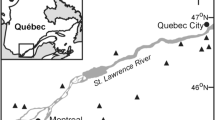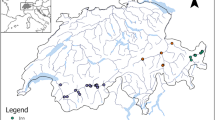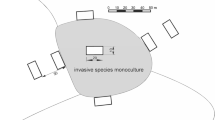Abstract
The relationship between diversity and composition of neotropicalbromeliad communities and abiotic and autecological factors is still poorlyunderstood. In this study, I related point diversity (mean species number per400 m2 plot), α diversity (total species number persite), representation of life-forms (epiphytes, terrestrials, saxicoles), andsix ecophysiological types of bromeliads at 74 forest sites in the BolivianAndes and adjacent lowlands to 12 environmental factors reflecting mostlyclimatic conditions. A total of 192 species, including 108 epiphytes, 106saxicoles, and 49 terrestrials, were recorded. Extrapolation revealed that theactual total species number in the region is at least 24% higher than recorded,especially among terrestrial (71%) and saxicolous (40%) species. Epiphytes weremore fully sampled because of their tendency towards larger range size andbecause they are distributed more evenly where they occur. Overall, theenvironmental factors explained up to 61% of the observed variance, reflectingall expected relationships such as the increase of tank bromeliads in wethabitats and of atmospheric bromeliads in arid regions. Point diversity almostalways showed higher regression coefficients than α diversity, possibly as aresult of more complete sampling in small plots and because the abundance ofindividual species (which influences point diversity) may be more closelyrelated to abiotic factors than species richness. Despite somewhat lowerα diversity in arid areas, point diversity peaked in dry habitats,presumably due to the scarcity of competing epiphytic orchids, ferns, and aroidsthat lack the extreme adaptation of bromeliads to drought stress and lownutrient availability. The decline of epiphytic bromeliad diversity at highelevations appears to be linked to low temperatures, particularly increasingfrost frequency. It is hypothesized that the low diversity of bromeliads inhumid tropical lowland forests is caused by low photosynthetic rates due to highwater stress and low light availability combined with high respiration losses.In combination, these factors would impede the maintenance of a positive carbonbalance.
Similar content being viewed by others
References
Andrade J.L. and Nobel P.S. 1997. Microhabitats and water relations of epiphytic cacti and ferns in a lowland Neotropical forest. Biotropica 29: 261-270.
Balslev H., Valencia R., Paz y Miño G., Christensen H. and Nielsen I. 1999. Species count of vasular plants in one hectare of humid lowland forest in Amazonian Ecuador. In: Dallmeier F. and Comiskey J.A. (eds), Forest Biodiversity in North, Central and South America and the Caribbean. Research and Monitoring. UNESCO, Paris and Parthenon Publishing Group, New York. Man and the Biosphere series 21, pp. 585-594.
Benzing D.H. 1990. Vascular Epiphytes. Cambridge University Press, New York.
Benzing D.H. 2000. Bromeliaceae. Profile of an Adaptive Radiation. Cambridge University Press, Cambridge.
Chao A. 1987. Estimating the population size for capture-recapture date with unequal catchability. Biometrics 43: 783-791.
Cowell R.K. and Coddington J.A. 1995. Estimating terrestrial biodiversity through extrapolation. In: Hawksworth D.L. (ed.), Biodiversity. Measurement and Estimation. Chapman and Hall, London, pp. 101-118.
Ellenberg H. 1981. Ursachen desVorkommens und Fehlens von Sukkulenten in den Trockengebieten der Erde. Flora171: 114-169.
Eriksen W. 1986. Frostwechsel und hygrische Bedingungen in der Puna Boliviens. Ein Beitrag zur Ökoklimatologie der randtropischen Anden Bolivien. In: Buchholz H.J. (ed.), Beiträge zur physischen Geographie eines Andenstaates. Jahrbuch Geographischen Gesellschaft Hannover 1985, Hannover, pp. 1-21.
Fischer E.A. and Araujo A.C. 1996. The bromeliad flora of the Rio Verde estuary (Juréia, São Paulo): a comparison with other neotropical communities. Bromelia 3: 19-25.
Fjeldså J., Lambin E. and Mertens B. 1999. Correlation between endemism and local ecoclimatic stability documented by comparing Andean bird distributions and remotely sensed land surface data. Ecography 22: 63-78.
Fontoura T. 1995. Distribution patterns of five Bromeliaceae genera in Atlantic rainforest, Rio de Janeiro State, Brazil. Selbyana16: 79-93.
Fredericksen T.S., McDonald E., Wright K. and Mostacedo B. 1999. Ecología de la bromeliácea terrestre Pseudananas sagenarius (Bromeliaceae, Bromelioideae) en bosques secos de Bolivia. Rev. Soc. Boliviana Bot. 2: 165-173.
Gentry A.H. and Dodson C.H. 1987. Diversity and biogeography of neotropical vascular epiphytes. Annals of the Missouri Botanical Gardens 74: 205-233.
Haffer J. 1987. Quaternary history of tropical America. In: Whitmore T.C. and Prance G.T. (eds), Biogeography and Quaternary History in Tropical America. Oxford University Press, Oxford, pp. 1-18.
Hietz P. and Hietz-Seifert U. 1995. Composition and ecology of vascular epiphyte communities along an elevational gradient in central Veracruz, Mexico. Journal of Vegetation Science 6: 487-498.
Ibisch P.L. 1996. Neotropische Epiphytendiversitat-das Beispiel Bolivien. Archiv naturwissenschaftlicher Dissertationen 1 Martina Galunder-Verlag, Wiehl, Germany.
Ibisch P.L. 1998. Bolivia is a megadiversity country and a developing country. In: Barthlott W. and Winiger M. (eds), Biodiversity. A Challenge for Development Research and Policy. Springer, Berlin, pp.213-242.
Ibisch P.L., Boegner A., Nieder J. and Barthlott W. 1996a. How diverse are neotropical epiphytes ? An analysis based on the “Catalogue of the flowering plants and gymnosperms of Peru”. Ecotropica 1: 13-28.
Ibisch P.L., Rojas P., de la Barra N., Fernández E., Mercado M., Ovando L. et al. 1996b. Un “lugar deencuentro”: Flora de la zona arqueológica “El Fuerte”, Samaipata (Prov. Florida, Dpto. Santa Cruz, Bolivia). Ecología en Bolivia 28: 1-28.
Ibisch P.L. and Vasquez R. 2000. Illustrated Catalogue of the Bromeliaceae of Bolivia. FAN, Santa Cruz, Bolivia, CD-Rom.
Ibisch P.L., Vásquez R. and Gross E. 1999. New species of Puya and Pitcairnia (Bromeliaceae) from the Amboró National Park and vicinities (Santa Cruz, Bolivia): a neglected center of diversity and endemism of Pitcairnioideae. Journal of the Bromeliad Society 49: 124-135.
Johansson D.R. 1974. Ecology of vascular epiphytes in west African rain forests. Acta Phytogeographica Suecica 59: 1-136.
Jordan E. 1991. Die Gletscher der bolivianischen Anden. Franz Steiner Verlag, Stuttgart.
Kessler M. 2001. Pteridophyte species richness in Andean forests in Bolivia. Biodiversity and Conservation 10: 1473-1495.
Kessler M. and KrÖmer T. 2000. Patterns and ecological correlates of pollination modes among bromeliad communities of Andean forests in Bolivia. Plant Biology 2: 659-669.
Killeen T.J., Jardim A., Mamami F., Rojas N. and Saravia P. 1998. Diversity, composition, and structure of a tropical deciduous forest in the Chiquitanía region of Santa Cruz, Bolivia. Journal of Tropical Ecology 14: 803-827.
KrÖmer T., Kessler M., Holst B.K., Luther H.E., Gouda E., Till W. et al. 1999. Checklist of Bolivian Bromeliaceae with notes on species distribution and levels of endemism. Selbyna 20: 201-223.
Lieth H. 1975. Modeling the primary productivity of the world. In: Lieth H. and Whittaker R.H. (eds), Primary Productivity of the Biosphere. Springer-Verlag, New York, pp. 237-263.
Pareja J., Vargas C., Suárez R., Ballón R., Carrasco R. and Villarroel C. 1978. Mapa geológico de Bolivia. YPFB-Servicio Geológico de Bolivia, La Paz.
Parker T.A., Gentry A.H., Foster R.B., Emmons L.H. and Remsen J.V. Jr. 1993. The lowland dry forests of Santa Cruz, Bolivia: a global conservation priority. Conservation International, Washington, DC, RAP Working Papers.
Pittendrigh C.S. 1948. The bromeliad-Anopheles-malaria complex in Trinidad. I. The bromeliad flora. Evolution 2: 58-89.
Prendergast J.R., Quinn R.M., Lawton J.H., Eversham B.C. and Gibbons D.W. 1993. Rare species: the coincidence of diversity hotspots and conservation strategies. Nature 365: 335-337.
Rahbek C. 1997. The relationship among area, elevation, and regional species richness in neotropical birds. American Naturalist 149: 875-902.
Ricklefs R.E. and Schluter D. 1993. Species Diversity in Ecological Communities. Historical and Geographical Perspectives. University of Chicago Press, Chicago, Illinois.
Rosenzweig M.L. 1995. Species Diversity in Space and Time. Cambridge University Press, New York.
Saldias P.M. 1991. Inventario de árboles en el bosque alto del Jardín Botánico de Santa Cruz, Bolivia. Ecología en Bolivia 17: 31-46.
Schimper A.F.W. 1888. Die epiphytische Vegetation Amerikas. G. Fischer, Jena, Bot. Mitt. Tropen II.
Secink J. 1984. An altitudinal sequence of soils in the Sierra Nevada de Santa Marta. Studies on Tropical Andean Ecosystems 2: 131-138.
Smith L.B. 1934. Geographical evidence on the lines of evolution in the Bromeliaceae. Bot. Jahrb. Syst. 66: 446-485.
Smith L.B. and Downs R.J. 1977. Bromeliaceae. Part 2. Tillandsioideae Flora Neotropica Monograph 14. The New York Botanical Garden, Bronx, New York.
Sugden A.M. 1981. Aspects of the ecology of vascular epiphytes in two Colombian cloud forests: II. Habitat preferences of Bromeliaceae in the Serrania de Macuria. Selbyana 5: 264-273.
SYSTAT 1997. SYSTAT for Windows, statistics, version 7.0. SPSS Inc., Chicago, Illinois.
ter Steege H. and Cornelissen J.H.C. 1989. Distribution ecology of vascular epiphytes in lowland rainforest of Guyana. Biotropica 21: 331-339.
Terborgh J. 1977. Bird species diversity on an Andean elevational gradient. Journal of Ecology 58: 1007-1019.
Vásquez R. 1994. Un viaje de observación botánica a la región de Ivitiapi (Provincia Cordillera, Departamento de Santa Cruz). Rev. Soc. Estudios Botánicos 1: 61-69.
Walther B.A. and Morand S. 1998. Comparative performance of species richness estimation methods. Parasitology 116: 395-405.
Whittaker R.H. 1972. Evolution and measurement of species diversity. Taxon 21: 213-251.
Wolf J.H.D. 1993. Diversity patterns and biomass of epiphytic bryophytes and lichens along an altitudinal gradient in the northern Andes. Annals of the Missouri Botanical Gardens 80: 928-960.
Zotz G. 1997. Substrate use by three bromeliads. Ecography 20: 264-270.
Zotz G. and Andrade J.L. 1997. Water relations of two co-occurring epiphytic bromeliads. Journal of Plant Physiology 152: 545-554.
Author information
Authors and Affiliations
Rights and permissions
About this article
Cite this article
Kessler, M. Species richness and ecophysiological types among Bolivian bromeliad communities. Biodiversity and Conservation 11, 987–1010 (2002). https://doi.org/10.1023/A:1015875807613
Issue Date:
DOI: https://doi.org/10.1023/A:1015875807613




